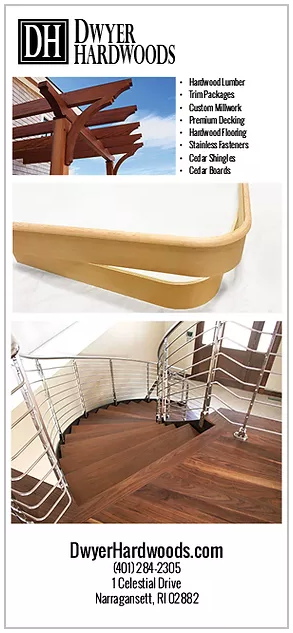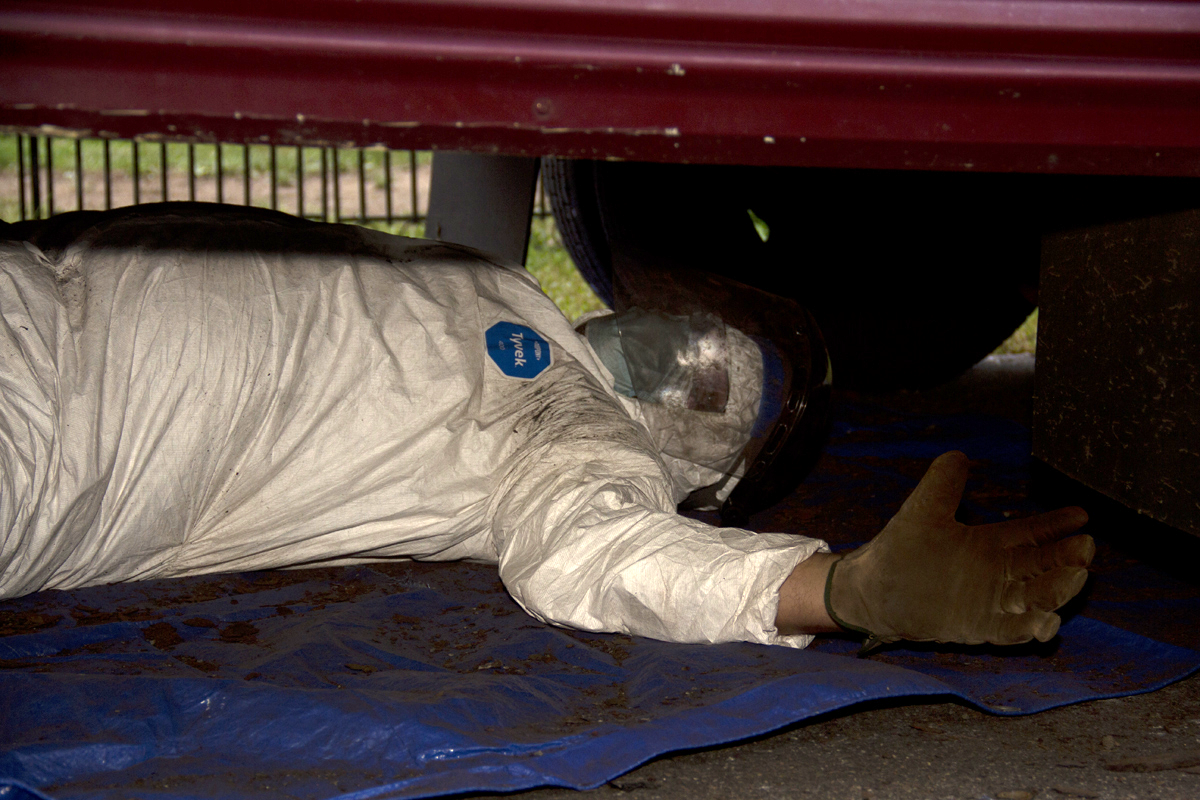
Fighting claustrophobia in a HAZ-MAT suit whilst wielding a grinder.
One of my favorite books/movies of all time is Stephen King’s Christine, about the ’58 Plymouth Fury that comes back to life and kills people that have harmed her in the past. I first saw it when I was 10 and read the book as soon as I knew it was a book first. I’ve always loved the idea of bringing something back to life, restoring something that was previously thought to be junk, particularly in our throw-away society. Plus, I was one of those weirdos who would listen to 50’s music in the 80’s and absolutely loved that era of car – fins and all.
There’s a scene in the movie where Arnie, the car’s new owner, stores her in a facility while he works on restoring her to her former chromed glory. While Arnie restores the car, unbeknownst to Arnie at first – and everyone else – Christine is also working on restoring herself. But, presumably because she’s a car, she’s doing it in a haphazard, random sorta way. This line from Darnell, who owns the storage facility, sums it up this way: “He’s got f@$&in’ brand-new windshield wipers for a busted windshield.” Then, as the scene plays on, we see that half the grille is restored, while the other half is still old and rusty. New hubcaps, old tires, half a painted hood, that sort of thing.
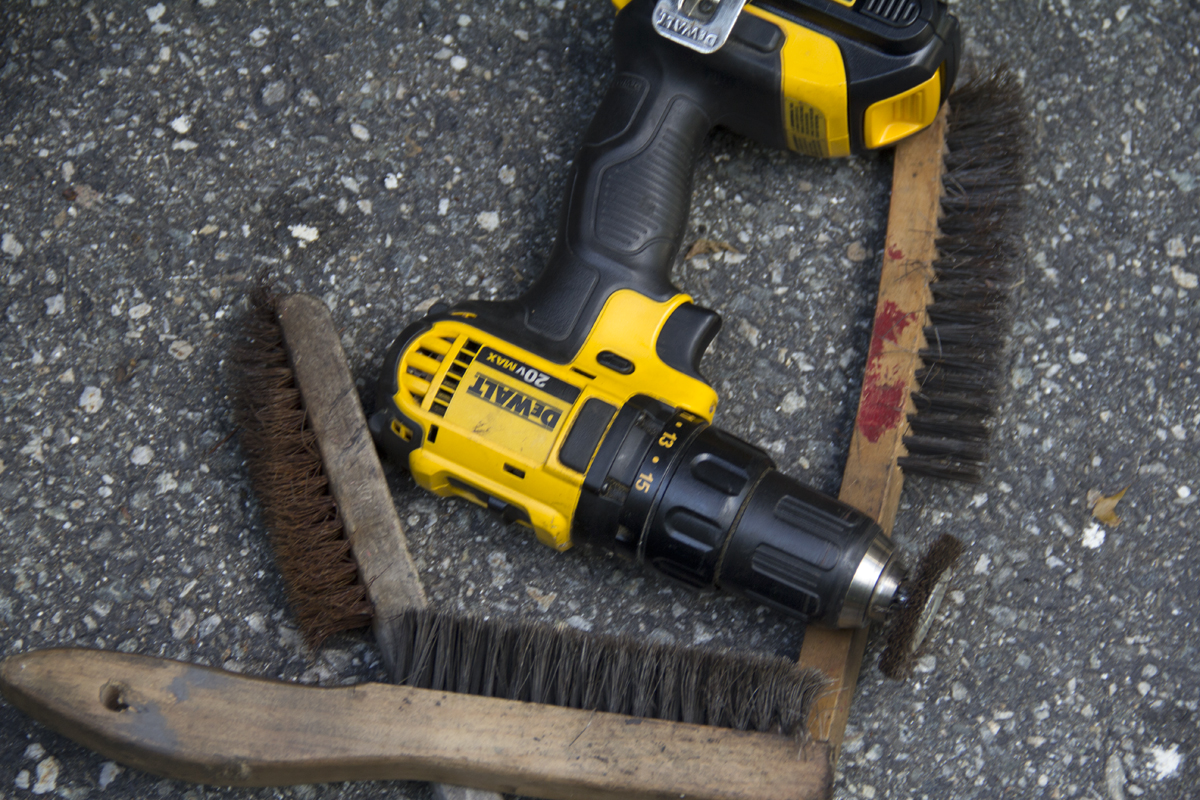
Anti-Rusters 101. We started with these to get the bigger chunks, but had to quickly upgrade to an indistrial-strength grinder with a wire wheel so stiff and menacing, it looked it could rip our faces off just standing still.
Sunny, while possessed only with a happy disposition and beachy vibe, kind of looked like Christine underneath. She was plagued with rust in random places, like she was parked over a puddle for a few years, then random parts were replaced, but others not so much. One rear brake caliper was nearly new. The other looks like it was just hauled up from the Titanic. One new rubber brake line. One new shock mount. One leaf-spring pack looked like it was installed two years ago, while the other looked original.
Was she a demon? Of course not. My detective skills told me that the previous owner only replaced things when they broke and not with best practices. For instance, paired parts on vehicles should be replaced in pairs, like shocks, brake parts, springs, etc. It helps restore balance to the rig.
All of that said, this rust wasn’t going to fix itself. This is the part where I wanted Sunny to be possessed – a little. Imagine if she was a self-repairing skoolie? Rust remediation, particularly on a large vehicle like our bus, is no easy task. I really, really feel for those people out there that went for a full-size skoolie in this neck of the woods. Alas, we set about the task.
For me, this was possibly the worst part of the build. I am extremely claustrophobic and hate loud noises (I use foam ear plugs and ear muffs when using power tools). The de-rusting process required a Tyvek HAZ-MAT suit, face shield, ear plugs x2, a wire-wheel on an angle grinder and hours spent underneath the bus wriggling around on our backs with power tools that would rip our faces off is we dropped them at the wrong time.
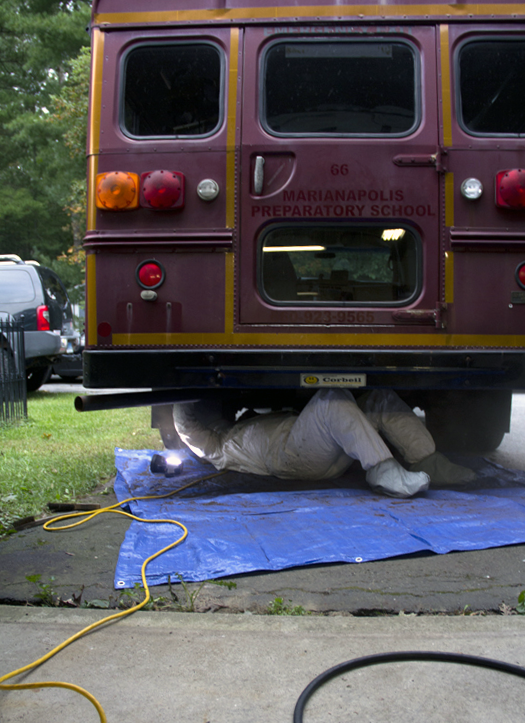
More grinding in my least favorite suit of all time.
I had to psyche myself up to do this work, so I got into rally mode and just started going bananas. I wire-wheeled about 9 pounds of rust into my eyes, ears, and hair (even with the suit) before I got into spots so tight I couldn’t breathe. Then Steph jumped in after a 3-second lesson on the grinder. She also went bananas.
After 9 years of rust removal, we blew off all the rust dust and hit a few greasy spots of brake cleaner. We rattle-canned some rust conversion paint, Rustoleum, on the underside of the floor, bus frame, shock mounts, rear axle, bumper mounts, and any other place we could find. When we ran out of Rustoleum, I found a can of Permatex Rust Converter and used that as well. I marked the spots (in my mind) where we used each, so over time we can see which one worked better (or at all) for sealing in and/or converting rust. After much research on Steph’s part, we used POR-15 in the inside metal floor (see future post). POR is supposed to be the gold standard, but it also costs as much as gold. As this is a budget build, allegedly, we’re starting cheap and going up from there.
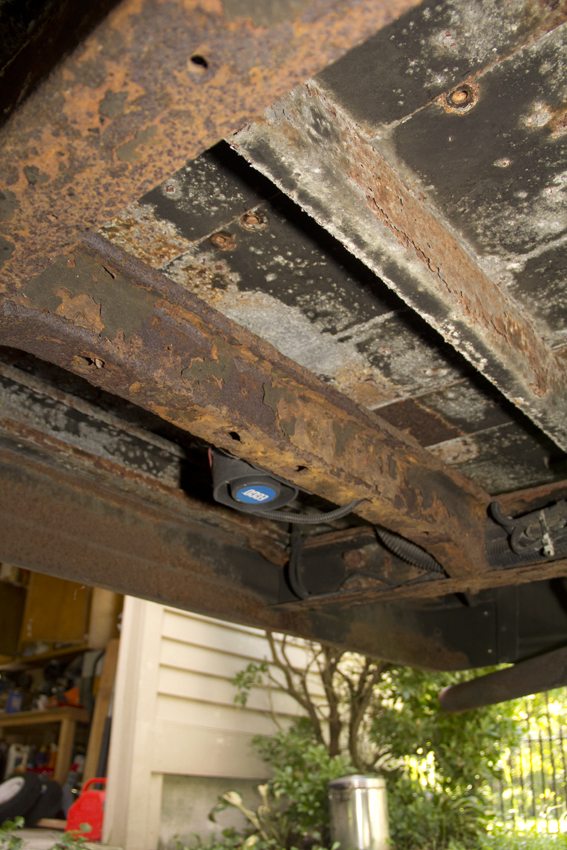 Now that most everything under the rear of the bus, up to about the gas tank amidships, was covered in rust preventing paint, I breathed a little easier. The front of the bus, in random places, still needs to be done, but the worst is behind us. Also, while I was under there, I disconnected the back-up alarm, that construction site beeeeep-beeeeep-beeeeep was more than I – and my neighbors – could take. I do, however, want to hook it back up, but put it on a cab-mounted switch, so I can manually turn it on and off, as I do think it would be helpful in busy parking lots and rally service areas.
Now that most everything under the rear of the bus, up to about the gas tank amidships, was covered in rust preventing paint, I breathed a little easier. The front of the bus, in random places, still needs to be done, but the worst is behind us. Also, while I was under there, I disconnected the back-up alarm, that construction site beeeeep-beeeeep-beeeeep was more than I – and my neighbors – could take. I do, however, want to hook it back up, but put it on a cab-mounted switch, so I can manually turn it on and off, as I do think it would be helpful in busy parking lots and rally service areas.
Now, there was one major thing left under there that we had to take care of as well. We noticed inside that there was a soft spot when walking fore and aft, just behind the wheel well protrusions. Once again under the bus, I noticed that there are several C-Channel beams that mount the coach part of the bus that mount perpendicularly onto the factory truck frame. The one behind the wheel wells, which also carried the mud flaps, was just about completely rotten and rusted away into the abyss of time and space.
The good news was that it looked like when removed, we could just unbolt it and slide it out and replace it with a new one. That job, like others on a skoolie, was not as easy at it sounded. Check out what we had to do to get this job done next week. Until then, I’m going to go pick rusty chunks of bus out of my eyeballs.

